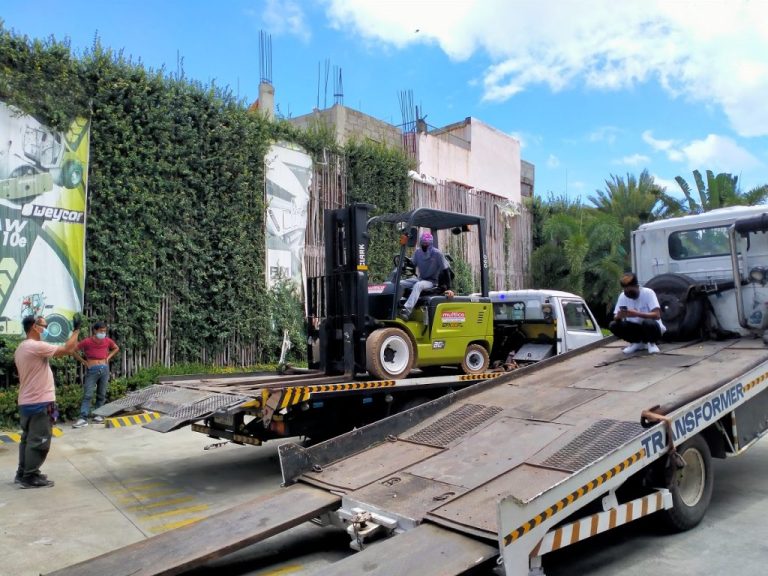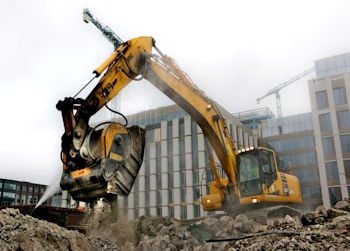Types of Demolition Machines | Demolition Attachments
Keywords: excavator demolition attachments, excavator attachments for demolition
Demolition projects require rugged equipment that can handle challenging tasks like breaking up hard objects into smaller pieces and pushing, clearing, loading and hauling large amounts of debris. These machines must be well-designed and solidly constructed to perform these functions throughout the workday.
Versatility is also a desirable trait in demolition equipment. The ability to perform multiple functions with one machine saves time, increases productivity and reduces operating costs.
Several versions of demolition machinery are essential at many of these high-demand job sites to complete the work quickly and efficiently.
TYPES OF DEMOLITION EQUIPMENT
You’ll likely need these demolition machines to break down, handle and load materials at your site.
EXCAVATORS
Excavators are one of the most common equipment types found at demolition sites. These powerful digging machines are extremely versatile. They’re an excellent choice for knocking down building walls and scooping and removing debris.
Excavators are available in multiple sizes, making it easy to match the equipment with the task at hand — choose from mini, small, medium, large and extra-large models. Caterpillar manufactures demolition excavators that include a specially designed cab, a straight boom and a higher reach capacity.
You can also choose the undercarriage style based on your application. A wheeled unit provides a higher reach and additional speed to move faster at larger sites, while a tracked version offers more stability when navigating uneven terrain.
Many excavator models are compatible with multiple work tool attachments that enable you to perform various tasks with one machine:
- Hammers: A hydraulic hammer allows you to smash concrete and other hard debris for easier handling and removal.
- Thumbs: A thumb can “grab” and move materials and assist with demolishing and loading smaller objects.
- Shears: Use this attachment to cut and process steel for recycling and help with tearing down larger structures.
SKID STEERS
A skid steer loader might be the most agile and versatile machine you can use at your sites. This small demolition equipment can easily maneuver around piles of debris. It also features a tight turning radius, which is beneficial when working in confined areas. Despite their size, skid steers are surprisingly powerful. They can handle the rigors of demolition sites and help keep the work on schedule.
The skid steer’s versatility comes from the machine’s ability to accommodate numerous attachments, including:
- Buckets: A bucket is the most commonly used attachment at many demolition sites, as it enables the machine to lift heavy materials. You could also opt for a grapple bucket to secure uneven or irregularly shaped loads.
- Hammers: Use hydraulic hammers to break up concrete at construction sites or smash bulky objects into smaller pieces for easier removal.
- Brooms: These attachments allow you to sweep debris from flat surfaces after completing the demolition process.
- Forks: Equipping your skid steer with pallet forks lets the machine double as a forklift to perform various material handling tasks at your sites.
- Backhoes: A backhoe can transform your skid steer loader into a powerful digging machine for demolition-related excavation tasks.
TRACK LOADERS
A compact track loader (CTL) resembles a skid steer in size and configuration, but it features one important distinction. Instead of wheels, a CTL uses tracks to propel the machine. While a skid steer is faster, a compact track loader provides better traction, making it a more practical demo equipment choice when working at sites with uneven or undeveloped terrain.
You should also consider using a track loader if the demolition site consists of soft, muddy ground, as the tracks reduce the risk of the machine getting stuck and bogging down. The difference in speed is of minimal concern if you’re working at a smaller site that requires covering shorter distances.
When deploying the appropriate attachments, a CTL can perform many of the same tasks as a skid steer loader. For example, you’ll be able to break ground and scoop materials with a bucket, smash concrete and other solid objects with a hydraulic hammer, and excavate with a backhoe.
Caterpillar manufactures compact track loaders in multiple power and rated output capacities to meet any demolition site performance requirements. All models provide the versatility, traction and maneuverability you need to complete your projects faster and more efficiently.
EQUIPMENT FOR MOVING DEMOLITION DEBRIS
Most demolition jobs require pushing large volumes of concrete, steel and other debris into piles for easier disposal and transporting these materials around the site. Multiple demolition machines are available to help you execute these demanding tasks.
ARTICULATED TRUCKS
Unlike a rigid dump truck, where the body and cab rest on the same fixed chassis, an articulated truck features a cab attached to a tipping body located directly behind it. This unique design makes the articulated model more flexible and maneuverable. The pivoting cab also provides a sharper turning radius, which is essential when attempting to navigate congested sites efficiently and safely.
Articulated trucks are ideal for the rough terrain present at many demolition sites. Many newer models include technologically advanced features like automatic traction control for enhanced stability in more challenging ground conditions.
Another benefit of using articulated trucks at demolition sites is their ability to haul heavy loads. Depending on the model, a Cat® truck can provide a payload capacity ranging from 26.5 to 55 tons. You can also choose between a three-axle version for general material transport duties or a bare chassis option for high-capacity hauling and other specialized applications.
DOZERS
The bulldozer has been a construction site staple for decades and is among the many pieces of equipment needed for demolition. The machine’s superior power and large front blade are perfect for pushing piles of debris around the site. They also have a rear-mounted ripper for breaking up hard-packed material or large chunks of concrete or stone.
Bulldozer blades come in several versions. A straight blade is short and flat, which is helpful for fine-grading applications after completing a demolition project. A universal blade features a taller curved design and side wings to maximize the load capacity. A combination blade, which is a hybrid of the straight and universal models, is the best choice for pushing larger, bulkier materials like chunks of concrete or rock.
Caterpillar manufactures a wide assortment of bulldozers with tracks (track-type tractors) that enable you to clear a path forward in all types of demolition work environments. Available sizes include small, medium and large to meet any pushing and moving requirements. You can also select a wheel version that provides additional speed and agility for navigating larger, open sites consisting of smooth, level terrain and fewer obstacles to impede their progress.
WHEEL LOADERS
Wheel loaders, also called front-end loaders, are perfect for various material moving and loading tasks at demolition sites. These versatile machines have a large bucket attached to the front for scooping debris and dumping it into an articulated truck or another vehicle.
Speed and maneuverability are key wheel loader benefits. Because the chassis rests on four wheels, the machine can move quickly through the job site and navigate around other equipment and piles of rubble. They can also scoop, transport and load all types of materials, including sand, dirt, gravel, rocks and the various waste generated in demolition applications.
Wheel loaders are available in multiple sizes to meet the material handling and loading needs at all types of demolition sites. You can also add numerous attachments to maximize their performance and versatility. Examples include:
- Buckets: The right bucket enables your wheel loader to adapt to the assortment of materials you may encounter at your demolition sites.
- Brooms: Use a broom attachment to sweep up loose dirt and debris from a wide range of surfaces after a demolition job.
- Forks: Attaching forks to your wheel loader enables it to serve as a forklift that can raise and load palletized materials onto trucks if needed.
LOUISIANA CAT IS YOUR ONE-STOP DEMOLITION MACHINE HEADQUARTERS
Louisiana Cat offers a wide assortment of machines used to demolish buildings in Louisiana. As the state’s exclusive Cat dealer, we carry an extensive selection of dozers, wheel loaders, excavators and other hardworking, dependable products from the world’s most recognized and respected equipment manufacturer. Our team will ensure you find the best model for your needs and budget.
We also stand behind all the demolition equipment we sell by delivering top-notch service. Whenever you need us, we’ll be there to keep your fleet in peak condition and maximize its life span.
Contact us to learn more about our demolition machinery and request a quote today.



